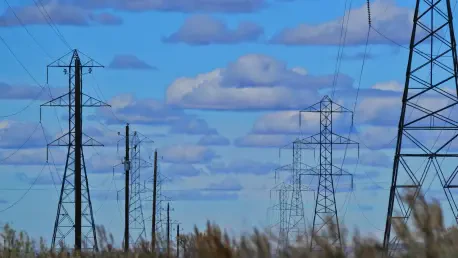Imagine a bustling metropolis where electric vehicles zip through the streets, industrial plants hum with electrified processes, and homes rely entirely on clean energy—yet the aging power grid struggles to keep up with this unprecedented demand, creating a pressing need for innovative solutions. This scenario is not a distant vision but a present-day challenge in regions like New York State, where electrification is accelerating at a remarkable pace. Grid-enhancing technologies (GETs) have emerged as a transformative solution to modernize outdated infrastructure, ensuring reliability without the burden of costly, time-intensive upgrades. This review delves into the core features, real-world applications, and future potential of GETs, spotlighting their role in reshaping energy systems for a sustainable era.
Understanding the Rise of Grid-Enhancing Technologies
The rapid shift toward electrification across transportation, heating, and industrial sectors has placed immense pressure on existing power grids, many of which were designed decades ago for a different energy landscape. With electric vehicle (EV) charging stations multiplying and new industrial loads like chip manufacturing demanding massive power, utilities face the daunting task of meeting spikes in consumption while maintaining stability. GETs offer a lifeline by optimizing current infrastructure rather than relying solely on extensive new construction, which can take years and strain budgets.
Traditional grid upgrades often involve building new transmission lines or substations, projects that are not only expensive but also face regulatory and environmental hurdles. In contrast, GETs provide faster, more adaptable solutions that can be deployed within months, addressing immediate needs without long-term overcommitment. This agility positions them as a critical tool in the energy transition, balancing the urgency of demand with the practicalities of cost and time.
Diving into the Core Features and Performance
Dynamic Line Ratings: Adapting to Real-Time Conditions
One of the standout components of GETs is dynamic line ratings (DLR), a technology that adjusts the capacity of transmission lines based on real-time environmental factors like temperature and wind speed. Unlike static ratings, which set fixed limits regardless of conditions, DLR allows utilities to safely increase power flow during favorable weather, effectively boosting grid capacity without physical modifications. This capability is particularly valuable during demand surges, such as heatwaves or sudden industrial loads.
The performance benefits of DLR are significant, often unlocking up to 30% more capacity on existing lines, as reported in various utility studies across the United States. By reducing the need for costly infrastructure investments, this technology not only enhances efficiency but also minimizes downtime during implementation. Its adaptability makes it a cornerstone of modern grid management, especially in densely populated regions where space for new lines is limited.
Power Flow Control Devices: Streamlining Electricity Routing
Another pivotal element of GETs is power flow control devices, which optimize the distribution of electricity across complex networks. These devices redirect power to less congested pathways, preventing bottlenecks and enhancing overall system reliability. Their technical sophistication lies in the ability to dynamically balance loads, ensuring that no single line or region is overwhelmed during peak usage periods.
In terms of performance, power flow control devices have proven instrumental in reducing transmission losses and improving grid stability, particularly in areas with high renewable energy integration. Real-world deployments have demonstrated their capacity to mitigate outages and extend the lifespan of existing infrastructure. This efficiency translates into tangible cost savings for utilities and, ultimately, for ratepayers who bear the burden of traditional upgrade expenses.
Cutting-Edge Developments and Adoption Trends
The landscape of GETs is evolving rapidly, with innovations like mobile energy storage units gaining traction as flexible solutions for localized demand challenges. These units can be deployed temporarily to support high-demand zones, such as EV fast-charging hubs, without requiring permanent infrastructure changes. Additionally, advancements in grid analytics and sensor technologies are enhancing the precision of GETs, enabling smarter decision-making for utilities.
A notable trend is the policy-driven integration of these technologies into long-term energy planning. In progressive regions, regulatory bodies are prioritizing GETs over conventional builds, recognizing their potential to deliver quicker results at lower costs. This shift is evident in frameworks that incentivize utilities to adopt innovative tools, reflecting a broader move toward sustainability and efficiency in grid modernization efforts.
New York State stands at the forefront of this trend, embedding GETs into its strategic planning through initiatives like transmission optimization proceedings and technology working groups. This systematic approach ensures that innovations are not merely stopgap measures but integral components of a resilient energy future, setting a benchmark for other regions to follow.
Practical Impact in New York State
In New York, GETs are already making a measurable difference, particularly in addressing the challenges posed by electrification. A striking example is the deployment of mobile energy storage units along the New York State Thruway to support fast-charging EV hubs. These hubs, which can draw power equivalent to thousands of households, often strain local grids, but mobile storage provides a rapid, cost-effective buffer that traditional upgrades cannot match.
This application highlights the broader implications of GETs for energy planning. By offering solutions that can be implemented five times faster and at a fraction of the cost of conventional methods, New York is demonstrating how to manage demand growth without overbuilding infrastructure that might become obsolete. Such flexibility is crucial in a policy environment where energy needs and regulations are in constant flux.
Beyond EV infrastructure, GETs are also supporting industrial electrification and distributed energy resources across the state. Their ability to enhance grid reliability in diverse scenarios—from urban centers to rural corridors—underscores their versatility and positions New York as a leader in practical, scalable grid innovation.
Navigating Challenges and Limitations
Despite their promise, GETs are not without obstacles. Technical complexities, such as integrating new systems with legacy infrastructure, pose significant hurdles that require careful calibration to avoid disruptions. Additionally, the reliance on real-time data for technologies like dynamic line ratings demands robust cybersecurity measures to protect against potential vulnerabilities.
Regulatory challenges further complicate adoption, as existing frameworks are often tailored to traditional infrastructure projects rather than innovative tools. This mismatch can delay approvals or limit funding for GETs, even when their benefits are clear. Policymakers are actively working to address these gaps, but the process requires coordination across multiple stakeholders to ensure consistent implementation.
Another concern is the risk of over-dependence on interim solutions, which could lead to stranded investments if technologies become outdated or fail to scale. To mitigate this, comprehensive planning and periodic reassessment are essential, ensuring that GETs complement rather than replace long-term grid strategies. Collaborative efforts between utilities and regulators are key to striking this balance.
Looking Ahead to a Smarter Grid
The trajectory of GETs points toward deeper integration with renewable energy systems, where their ability to manage variable loads from solar and wind will be increasingly vital. Emerging advancements in artificial intelligence and predictive analytics are expected to further refine their capabilities, enabling grids to anticipate demand patterns with unprecedented accuracy. Such developments could redefine energy distribution over the next few years, from now until 2027.
Interstate collaboration also holds immense potential for scaling these solutions, as regions share data and best practices to tackle common challenges. By fostering alliances, states can accelerate the adoption of GETs, ensuring that innovations benefit a wider population. This collective approach could pave the way for a national framework that prioritizes grid efficiency and affordability.
The long-term impact of GETs on energy sustainability cannot be overstated. As they evolve, these technologies promise to lower costs for consumers while supporting ambitious clean energy targets, creating a grid that is not only resilient but also equitable in its reach and benefits.
Reflecting on a Transformative Journey
Looking back, the exploration of grid-enhancing technologies revealed a powerful shift in how power grids adapt to the demands of electrification. Their ability to optimize existing infrastructure with speed and cost-effectiveness marked a turning point for regions like New York State, where practical deployments showcased tangible benefits. The journey underscored that innovation, when paired with strategic planning, can bridge the gap between immediate needs and sustainable goals.
Moving forward, the focus should be on refining regulatory frameworks to streamline the integration of GETs, ensuring that technical and policy barriers do not hinder progress. Utilities and policymakers must prioritize investments in cybersecurity and scalability to safeguard these systems against future risks. Additionally, fostering partnerships across state lines will be crucial to amplify the impact of GETs, turning local successes into a nationwide blueprint for grid modernization.









